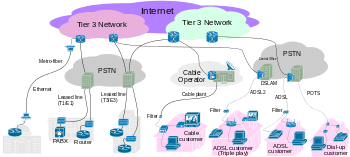
But if this is the end of net neutrality as we know it, it is not the end of the line for fair and equitable Internet access
LAST week’s proposal by the Federal Communications Commission to allow Internet service providers to charge different rates to different online content companies — effectively ending the government’s commitment to net neutrality — set off a flurry of protest.
The uproar is appropriate: In bowing before an onslaught of corporate lobbying, the commission has chosen short-term political expediency over the long-term interest of the country.
But if this is the end of net neutrality as we know it, it is not the end of the line for fair and equitable Internet access. Indeed, the commission’s decision frees Americans to focus on a real long-term solution: supporting open municipal-level fiber networks.
Such networks typically provide a superior and less expensive option to wholly private networks operated by Internet service providers like Comcast and Time Warner.
The idea of muni networks has been around for a while, with bipartisan support. When the Telecommunications Act was under discussion in 1994, Senator Trent Lott, Republican of Mississippi, was one of its most enthusiastic supporters. Thanks to him and others, the act, passed in 1996, prohibits states from putting up unreasonable obstacles to any entity that wants to provide telecommunications services.
So why didn’t a thousand muni networks bloom? After all, the 1996 act was aimed at increasing competition. But private providers rightly recognized muni networks as a threat, and in the subsequent decades have pushed through laws in 20 states that, despite the 1996 act, make it difficult or impossible for municipalities to clear the way for the sorts of networks that the 1996 act envisioned.
That means that the main problem behind getting muni networks up and running isn’t about the technology — which not only exists, but is already being used in large and small cities around the world — but about the politics.
The Latest on: Internet access
[google_news title=”” keyword=”Internet access” num_posts=”10″ blurb_length=”0″ show_thumb=”left”]
via Google News
The Latest on: Internet access
- Hades 2 Had An Impressive 24-Hour Start To Early Accesson May 7, 2024 at 9:49 pm
In case you somehow missed the internet exploding with excitement over it, Hades 2 has entered its Early Access period and fans are already having a great time with the highly anticipated sequel...a ...
- FEATURE-U.S. cities scramble as internet access benefit runs outon May 7, 2024 at 5:33 am
He said some 2,700 households across the county were enrolled in the ACP, and the county had created a "bridge" program, in partnership with a major local service provider, to help as many of those ...
- A Tech Too Far? School district’s internet policies spark debate among students about restricting accesson May 7, 2024 at 4:00 am
Whether it’s protecting students from dangerous websites, preventing access to sites students want, or impacting Wi-Fi connectivity, the school district’s internet policies play a significant role ...
- Millions of Americans could lose home internet access next monthon May 7, 2024 at 2:45 am
For many people, the ACP has allowed them to have internet access at home for the first time, and I think that’s important because we can’t do everything that we need to do on our cellphones. We can ...
- Affordable Connectivity Program Expiring: What This Means For Millions Of Americans’ Internet Accesson May 5, 2024 at 11:35 am
A $7 billion plan to extend the internet subsidy program through the end of the year has been proposed in the House and the Senate.
- Millions could pay more for internet access after government program expireson May 5, 2024 at 7:00 am
More than 20 million Americans have a tough decision to make, either pay a more expensive internet bill or disconnect from their service provider.
- Reliable, affordable internet access still a challenge for many Nigerians – NIGCOMSATon May 5, 2024 at 6:07 am
The Managing Director and Chief Executive Officer of the Nigeria Communications Satellite, NIGCOMSAT, Engr. James Egerton-Idehen has disclosed that reliable and affordable internet access remains a ...
- Millions of Americans may lose access to affordable internet program this monthon May 4, 2024 at 1:00 am
A federal program making affordable internet possible for roughly 23 million Americans is in danger of running out of funds if Congress doesn't act.
- One in six Georgia households will lose financial help for home internet access as federal program winds downon May 2, 2024 at 3:37 pm
Over 722,000 households in Georgia will soon lose access to a monthly assistance program used to help low-income people get online.
- Vallejo: 1.7 million Texans are about to lose affordable Internet access. Why hasn’t Monica De La Cruz Fought for Them?on May 1, 2024 at 8:53 am
The Affordable Connectivity Program has helped 90,000 households in Texas’ 15th Congressional District gain access to high-speed internet, saving them $30 to $75 a month.
via Bing News










